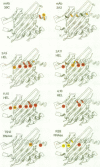Abstract
This report describes a detailed mutational analysis of a major histocompatibility complex class II molecule--the alpha chain of the Ak complex. Each residue from 50-79 was replaced by an alanine, and the effects on recognition of Ak by panels of antibodies and T cells determined. The results provide the strongest existing experimental evidence that the antigen binding site on a class II molecule can be modelled on the crystal structure of a class I molecule. The data have also permitted the delineation of residues that actually contact antigenic peptides.
Full text
PDF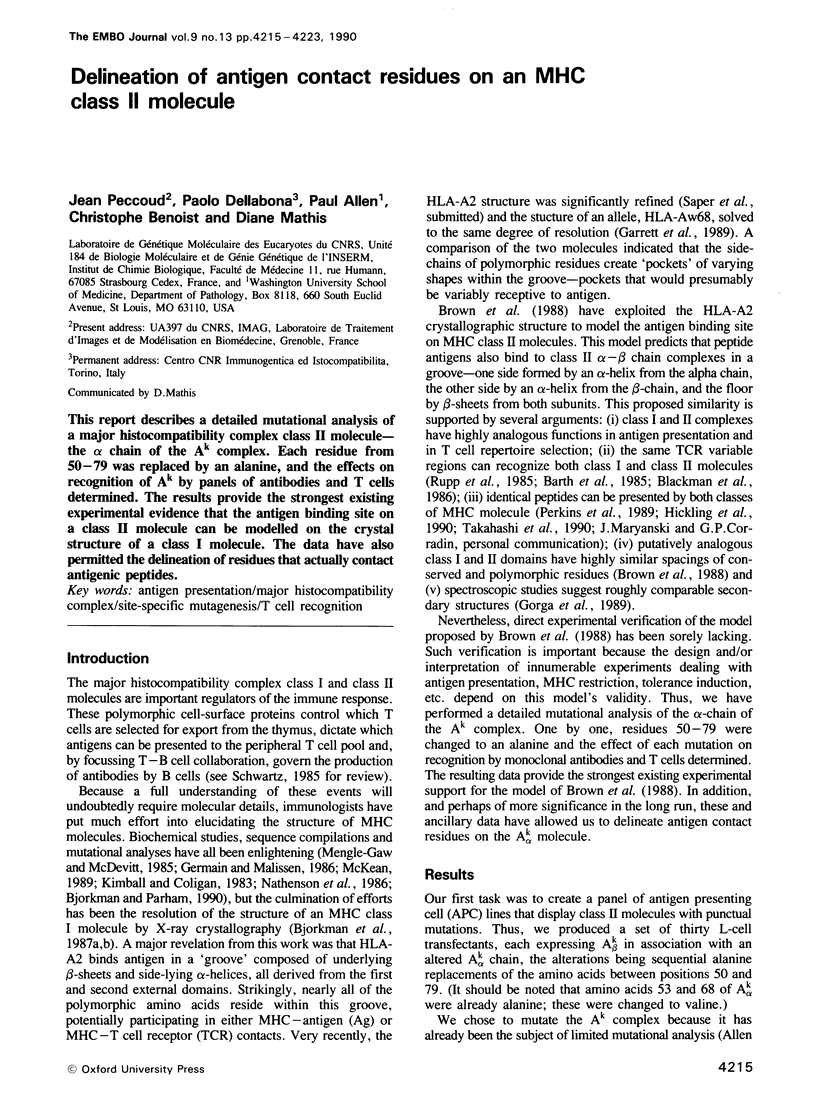

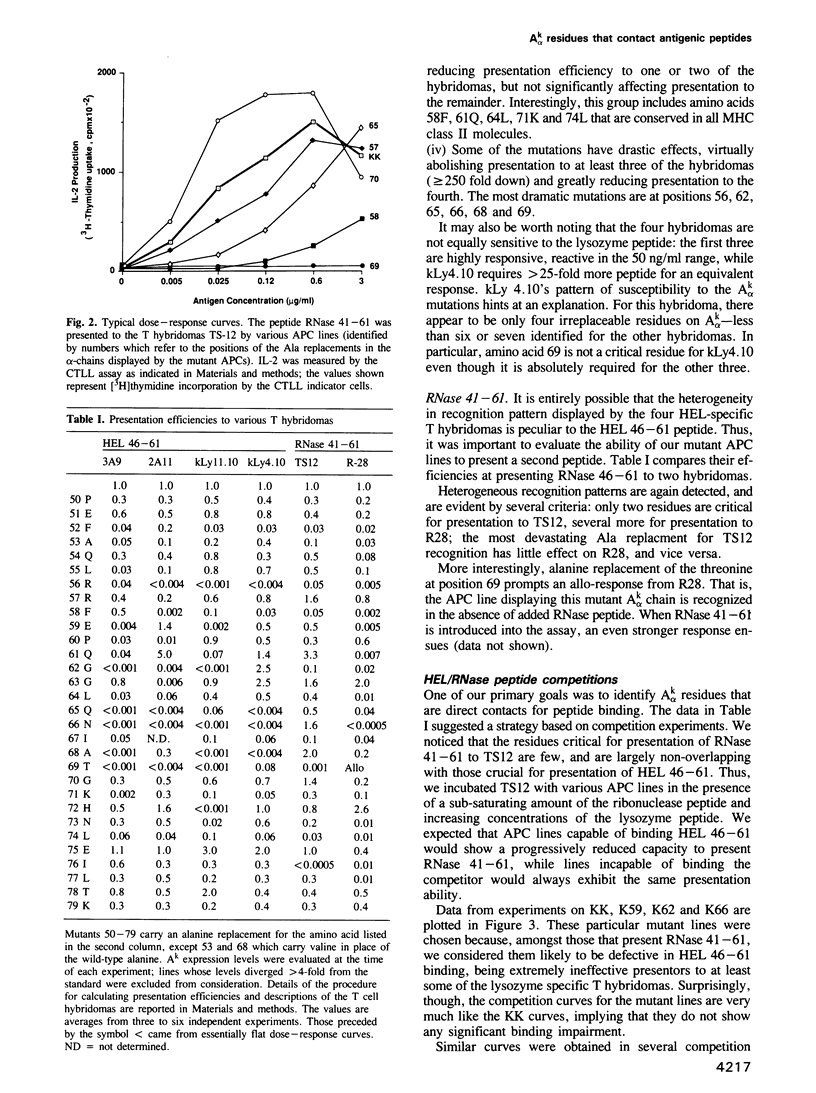
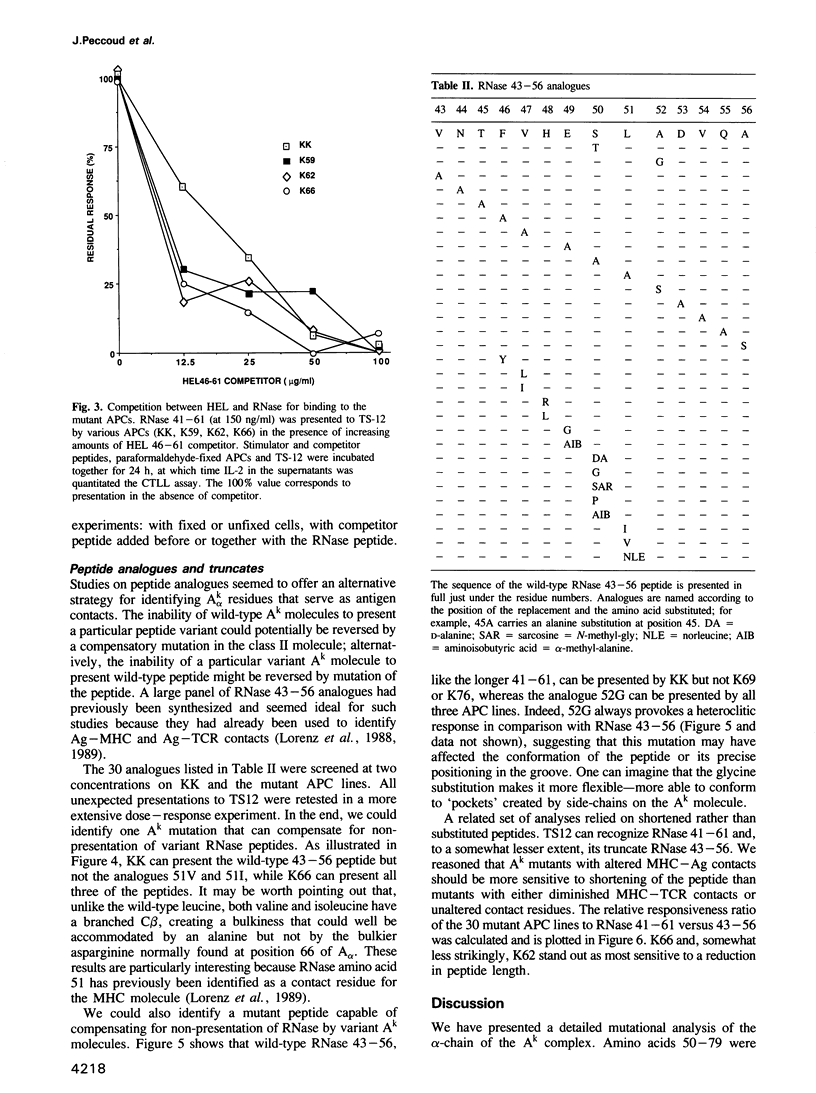
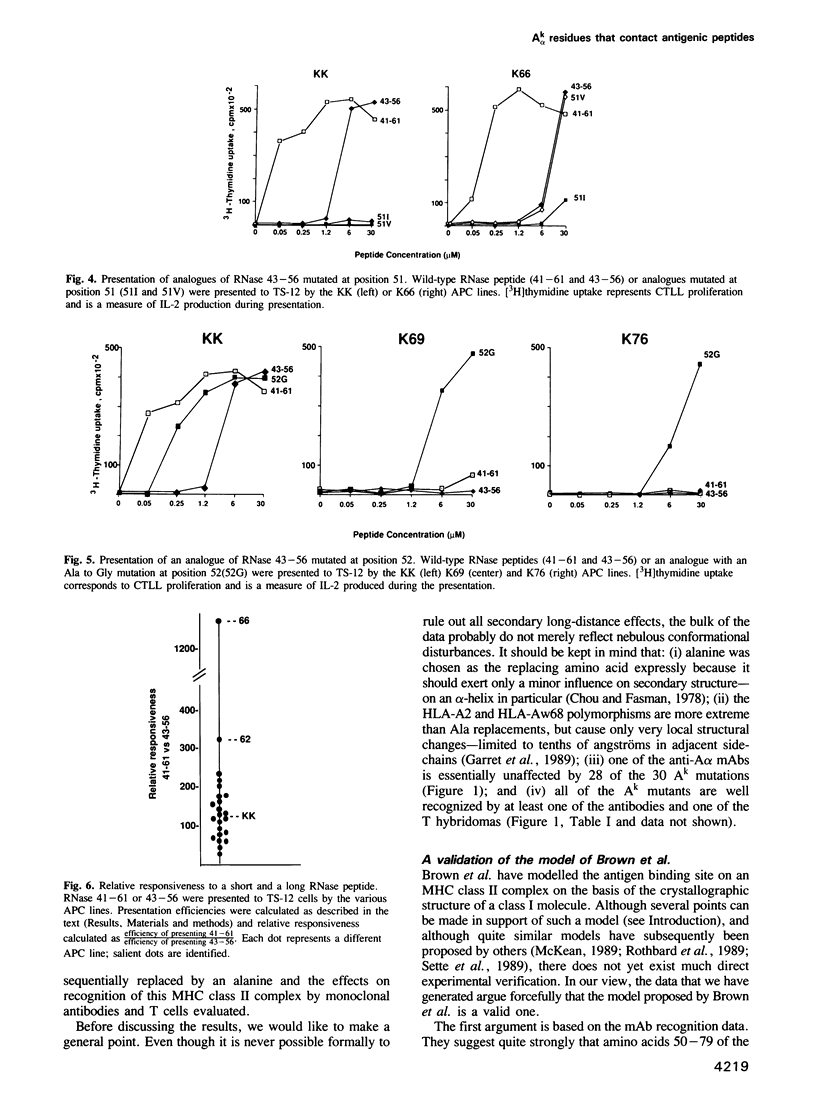
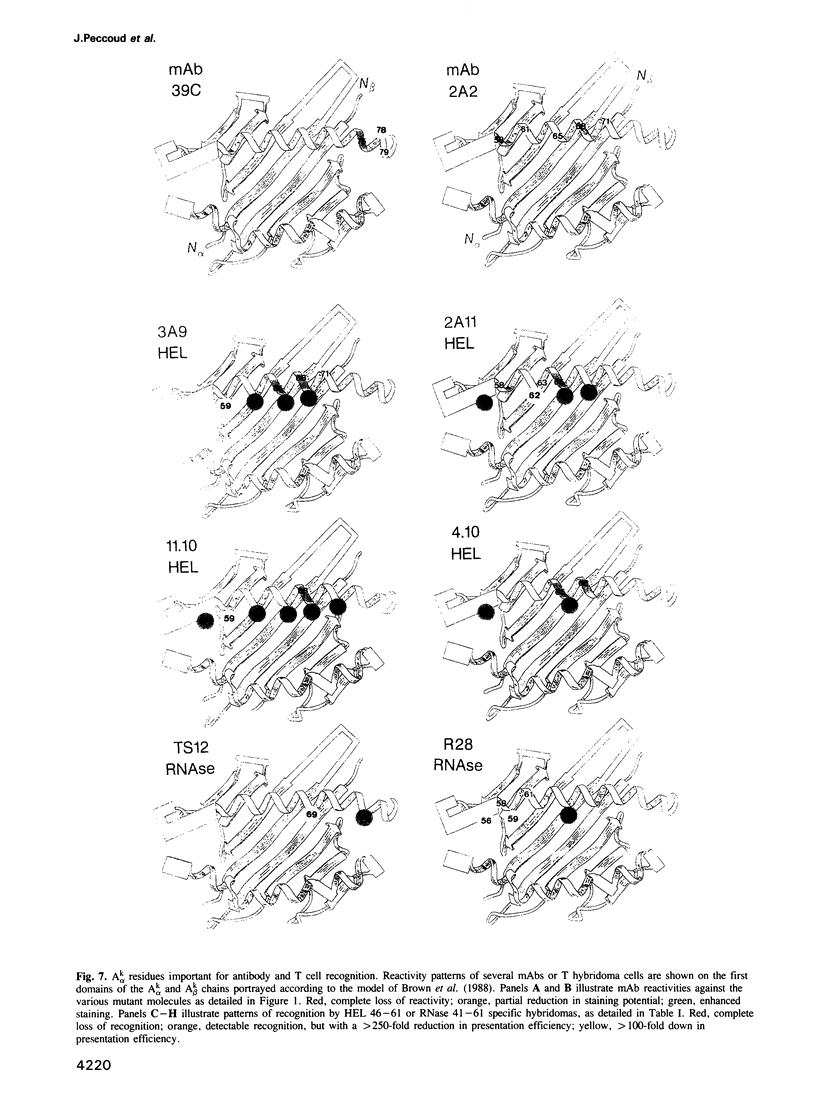
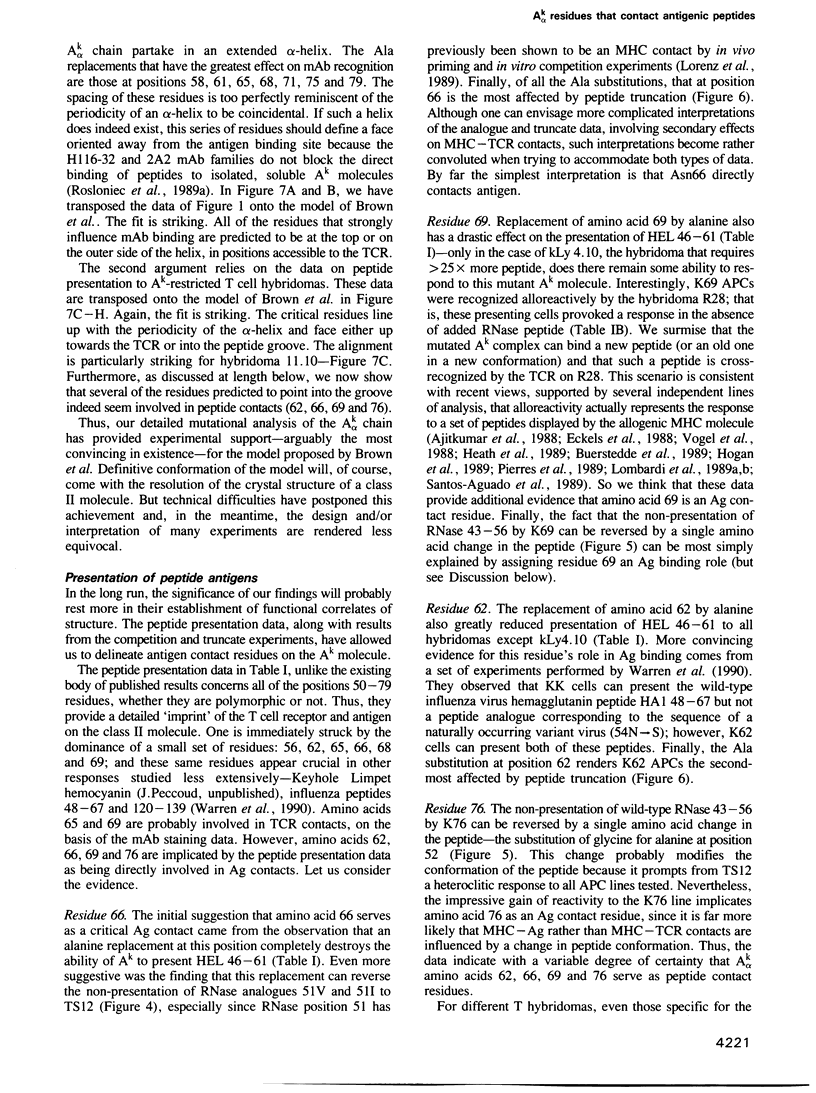
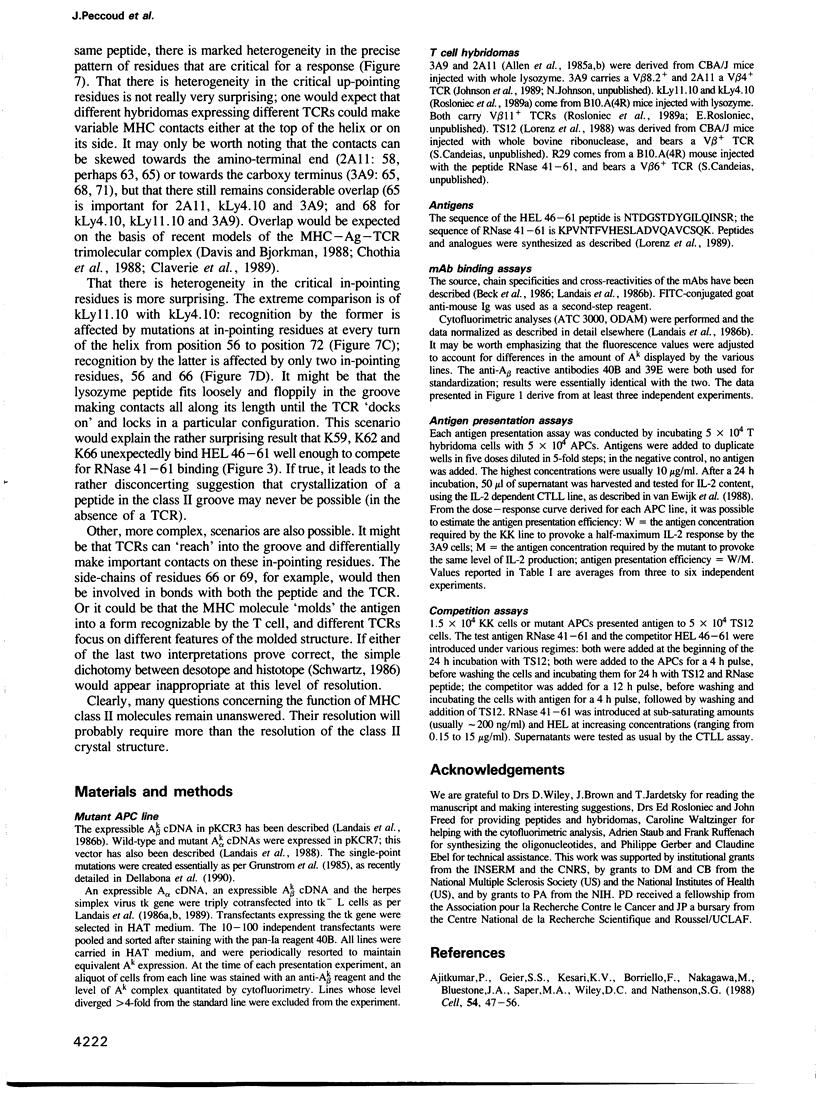

Images in this article
Selected References
These references are in PubMed. This may not be the complete list of references from this article.
- Ajitkumar P., Geier S. S., Kesari K. V., Borriello F., Nakagawa M., Bluestone J. A., Saper M. A., Wiley D. C., Nathenson S. G. Evidence that multiple residues on both the alpha-helices of the class I MHC molecule are simultaneously recognized by the T cell receptor. Cell. 1988 Jul 1;54(1):47–56. doi: 10.1016/0092-8674(88)90178-x. [DOI] [PubMed] [Google Scholar]
- Allen P. M., Matsueda G. R., Adams S., Freeman J., Roof R. W., Lambert L., Unanue E. R. Enhanced immunogenicity of a T cell immunogenic peptide by modifications of its N and C termini. Int Immunol. 1989;1(2):141–150. doi: 10.1093/intimm/1.2.141. [DOI] [PubMed] [Google Scholar]
- Allen P. M., Matsueda G. R., Evans R. J., Dunbar J. B., Jr, Marshall G. R., Unanue E. R. Identification of the T-cell and Ia contact residues of a T-cell antigenic epitope. 1987 Jun 25-Jul 1Nature. 327(6124):713–715. doi: 10.1038/327713a0. [DOI] [PubMed] [Google Scholar]
- Allen P. M., Matsueda G. R., Haber E., Unanue E. R. Specificity of the T cell receptor: two different determinants are generated by the same peptide and the I-Ak molecule. J Immunol. 1985 Jul;135(1):368–373. [PubMed] [Google Scholar]
- Allen P. M., McKean D. J., Beck B. N., Sheffield J., Glimcher L. H. Direct evidence that a class II molecule and a simple globular protein generate multiple determinants. J Exp Med. 1985 Oct 1;162(4):1264–1274. doi: 10.1084/jem.162.4.1264. [DOI] [PMC free article] [PubMed] [Google Scholar]
- Alzari P. M., Lascombe M. B., Poljak R. J. Three-dimensional structure of antibodies. Annu Rev Immunol. 1988;6:555–580. doi: 10.1146/annurev.iy.06.040188.003011. [DOI] [PubMed] [Google Scholar]
- Babbitt B. P., Matsueda G., Haber E., Unanue E. R., Allen P. M. Antigenic competition at the level of peptide-Ia binding. Proc Natl Acad Sci U S A. 1986 Jun;83(12):4509–4513. doi: 10.1073/pnas.83.12.4509. [DOI] [PMC free article] [PubMed] [Google Scholar]
- Barth R. K., Kim B. S., Lan N. C., Hunkapiller T., Sobieck N., Winoto A., Gershenfeld H., Okada C., Hansburg D., Weissman I. L. The murine T-cell receptor uses a limited repertoire of expressed V beta gene segments. Nature. 1985 Aug 8;316(6028):517–523. doi: 10.1038/316517a0. [DOI] [PubMed] [Google Scholar]
- Beck B. N., Buerstedde J. M., Krco C. J., Nilson A. E., Chase C. G., McKean D. J. Characterization of cell lines expressing mutant I-Ab and I-Ak molecules allows the definition of distinct serologic epitopes on A alpha and A beta polypeptides. J Immunol. 1986 Apr 15;136(8):2953–2961. [PubMed] [Google Scholar]
- Bjorkman P. J., Saper M. A., Samraoui B., Bennett W. S., Strominger J. L., Wiley D. C. Structure of the human class I histocompatibility antigen, HLA-A2. Nature. 1987 Oct 8;329(6139):506–512. doi: 10.1038/329506a0. [DOI] [PubMed] [Google Scholar]
- Bjorkman P. J., Saper M. A., Samraoui B., Bennett W. S., Strominger J. L., Wiley D. C. The foreign antigen binding site and T cell recognition regions of class I histocompatibility antigens. Nature. 1987 Oct 8;329(6139):512–518. doi: 10.1038/329512a0. [DOI] [PubMed] [Google Scholar]
- Blackman M., Yagüe J., Kubo R., Gay D., Coleclough C., Palmer E., Kappler J., Marrack P. The T cell repertoire may be biased in favor of MHC recognition. Cell. 1986 Nov 7;47(3):349–357. doi: 10.1016/0092-8674(86)90591-x. [DOI] [PubMed] [Google Scholar]
- Brown J. H., Jardetzky T., Saper M. A., Samraoui B., Bjorkman P. J., Wiley D. C. A hypothetical model of the foreign antigen binding site of class II histocompatibility molecules. Nature. 1988 Apr 28;332(6167):845–850. doi: 10.1038/332845a0. [DOI] [PubMed] [Google Scholar]
- Buerstedde J. M., Nilson A. E., Chase C. G., Bell M. P., Beck B. N., Pease L. R., McKean D. J. A beta polymorphic residues responsible for class II molecule recognition by alloreactive T cells. J Exp Med. 1989 May 1;169(5):1645–1654. doi: 10.1084/jem.169.5.1645. [DOI] [PMC free article] [PubMed] [Google Scholar]
- Buerstedde J. M., Pease L. R., Bell M. P., Nilson A. E., Buerstedde G., Murphy D., McKean D. J. Identification of an immunodominant region on the I-A beta chain using site-directed mutagenesis and DNA-mediated gene transfer. J Exp Med. 1988 Feb 1;167(2):473–487. doi: 10.1084/jem.167.2.473. [DOI] [PMC free article] [PubMed] [Google Scholar]
- Buerstedde J. M., Pease L. R., Nilson A. E., Bell M. P., Chase C., Buerstedde G., McKean D. J. Regulation of murine MHC class II molecule expression. Identification of A beta residues responsible for allele-specific cell surface expression. J Exp Med. 1988 Sep 1;168(3):823–837. doi: 10.1084/jem.168.3.823. [DOI] [PMC free article] [PubMed] [Google Scholar]
- Chothia C., Boswell D. R., Lesk A. M. The outline structure of the T-cell alpha beta receptor. EMBO J. 1988 Dec 1;7(12):3745–3755. doi: 10.1002/j.1460-2075.1988.tb03258.x. [DOI] [PMC free article] [PubMed] [Google Scholar]
- Chou P. Y., Fasman G. D. Empirical predictions of protein conformation. Annu Rev Biochem. 1978;47:251–276. doi: 10.1146/annurev.bi.47.070178.001343. [DOI] [PubMed] [Google Scholar]
- Claverie J. M., Prochnicka-Chalufour A., Bougueleret L. Implications of a Fab-like structure for the T-cell receptor. Immunol Today. 1989 Jan;10(1):10–14. doi: 10.1016/0167-5699(89)90058-3. [DOI] [PubMed] [Google Scholar]
- Davis C. B., Mitchell D. J., Wraith D. C., Todd J. A., Zamvil S. S., McDevitt H. O., Steinman L., Jones P. P. Polymorphic residues on the I-A beta chain modulate the stimulation of T cell clones specific for the N-terminal peptide of the autoantigen myelin basic protein. J Immunol. 1989 Oct 1;143(7):2083–2093. [PubMed] [Google Scholar]
- Davis M. M., Bjorkman P. J. T-cell antigen receptor genes and T-cell recognition. Nature. 1988 Aug 4;334(6181):395–402. doi: 10.1038/334395a0. [DOI] [PubMed] [Google Scholar]
- Eckels D. D., Gorski J., Rothbard J., Lamb J. R. Peptide-mediated modulation of T-cell allorecognition. Proc Natl Acad Sci U S A. 1988 Nov;85(21):8191–8195. doi: 10.1073/pnas.85.21.8191. [DOI] [PMC free article] [PubMed] [Google Scholar]
- Garrett T. P., Saper M. A., Bjorkman P. J., Strominger J. L., Wiley D. C. Specificity pockets for the side chains of peptide antigens in HLA-Aw68. Nature. 1989 Dec 7;342(6250):692–696. doi: 10.1038/342692a0. [DOI] [PubMed] [Google Scholar]
- Germain R. N., Malissen B. Analysis of the expression and function of class-II major histocompatibility complex-encoded molecules by DNA-mediated gene transfer. Annu Rev Immunol. 1986;4:281–315. doi: 10.1146/annurev.iy.04.040186.001433. [DOI] [PubMed] [Google Scholar]
- Gorga J. C., Dong A., Manning M. C., Woody R. W., Caughey W. S., Strominger J. L. Comparison of the secondary structures of human class I and class II major histocompatibility complex antigens by Fourier transform infrared and circular dichroism spectroscopy. Proc Natl Acad Sci U S A. 1989 Apr;86(7):2321–2325. doi: 10.1073/pnas.86.7.2321. [DOI] [PMC free article] [PubMed] [Google Scholar]
- Heath W. R., Hurd M. E., Carbone F. R., Sherman L. A. Peptide-dependent recognition of H-2Kb by alloreactive cytotoxic T lymphocytes. Nature. 1989 Oct 26;341(6244):749–752. doi: 10.1038/341749a0. [DOI] [PubMed] [Google Scholar]
- Hickling J. K., Fenton C. M., Howland K., Marsh S. G., Rothbard J. B. Peptides recognized by class I restricted T cells also bind to MHC class II molecules. Int Immunol. 1990;2(5):435–441. doi: 10.1093/intimm/2.5.435. [DOI] [PubMed] [Google Scholar]
- Hogan K. T., Clayberger C., Bernhard E. J., Walk S. F., Ridge J. P., Parham P., Krensky A. M., Engelhard V. H. A panel of unique HLA-A2 mutant molecules define epitopes recognized by HLA-A2-specific antibodies and cytotoxic T lymphocytes. J Immunol. 1989 Mar 15;142(6):2097–2104. [PubMed] [Google Scholar]
- Johnson N. A., Carland F., Allen P. M., Glimcher L. H. T cell receptor gene segment usage in a panel of hen-egg white lysozyme specific, I-Ak-restricted T helper hybridomas. J Immunol. 1989 May 1;142(9):3298–3304. [PubMed] [Google Scholar]
- Kimball E. S., Coligan J. E. Structure of class I major histocompatibility antigens. Contemp Top Mol Immunol. 1983;9:1–63. doi: 10.1007/978-1-4684-4517-6_1. [DOI] [PubMed] [Google Scholar]
- Landais D., Marchetto S., Waltzinger C., Pierres M., Benoist C., Mathis D. Slot-machine mutagenesis of a polymorphic residue on the A kappa alpha-chain. J Immunol. 1988 Jul 15;141(2):667–671. [PubMed] [Google Scholar]
- Landais D., Matthes H., Benoist C., Mathis D. A molecular basis for the Ia.2 and Ia.19 antigenic determinants. Proc Natl Acad Sci U S A. 1985 May;82(9):2930–2934. doi: 10.1073/pnas.82.9.2930. [DOI] [PMC free article] [PubMed] [Google Scholar]
- Landais D., Waltzinger C., Beck B. N., Staub A., McKean D. J., Benoist C., Mathis D. Functional sites on Ia molecules: a molecular dissection of A alpha immunogenicity. Cell. 1986 Oct 24;47(2):173–181. doi: 10.1016/0092-8674(86)90440-x. [DOI] [PubMed] [Google Scholar]
- Landias D., Beck B. N., Buerstedde J. M., Degraw S., Klein D., Koch N., Murphy D., Pierres M., Tada T., Yamamoto K. The assignment of chain specificities for anti-Ia monoclonal antibodies using L cell transfectants. J Immunol. 1986 Nov 1;137(9):3002–3005. [PubMed] [Google Scholar]
- Lombardi G., Sidhu S., Batchelor J. R., Lechler R. I. Allorecognition of DR1 by T cells from a DR4/DRw13 responder mimics self-restricted recognition of endogenous peptides. Proc Natl Acad Sci U S A. 1989 Jun;86(11):4190–4194. doi: 10.1073/pnas.86.11.4190. [DOI] [PMC free article] [PubMed] [Google Scholar]
- Lombardi G., Sidhu S., Lamb J. R., Batchelor J. R., Lechler R. I. Co-recognition of endogenous antigens with HLA-DR1 by alloreactive human T cell clones. J Immunol. 1989 Feb 1;142(3):753–759. [PubMed] [Google Scholar]
- Lorenz R. G., Tyler A. N., Allen P. M. Reconstruction of the immunogenic peptide RNase(43-56) by identification and transfer of the critical residues into an unrelated peptide backbone. J Exp Med. 1989 Jul 1;170(1):203–215. doi: 10.1084/jem.170.1.203. [DOI] [PMC free article] [PubMed] [Google Scholar]
- Lorenz R. G., Tyler A. N., Allen P. M. T cell recognition of bovine ribonuclease. Self/non-self discrimination at the level of binding to the I-Ak molecule. J Immunol. 1988 Dec 15;141(12):4124–4128. [PubMed] [Google Scholar]
- Mengle-Gaw L., McDevitt H. O. Genetics and expression of mouse Ia antigens. Annu Rev Immunol. 1985;3:367–396. doi: 10.1146/annurev.iy.03.040185.002055. [DOI] [PubMed] [Google Scholar]
- Mills K. H., Burt D. S., Skehel J. J., Thomas D. B. Fine specificity of murine class II-restricted T cell clones for synthetic peptides of influenza virus hemagglutinin. Heterogeneity of antigen interaction with the T cell and the Ia molecule. J Immunol. 1988 Jun 15;140(12):4083–4090. [PubMed] [Google Scholar]
- Nathenson S. G., Geliebter J., Pfaffenbach G. M., Zeff R. A. Murine major histocompatibility complex class-I mutants: molecular analysis and structure-function implications. Annu Rev Immunol. 1986;4:471–502. doi: 10.1146/annurev.iy.04.040186.002351. [DOI] [PubMed] [Google Scholar]
- Perkins D. L., Lai M. Z., Smith J. A., Gefter M. L. Identical peptides recognized by MHC class I- and II-restricted T cells. J Exp Med. 1989 Jul 1;170(1):279–289. doi: 10.1084/jem.170.1.279. [DOI] [PMC free article] [PubMed] [Google Scholar]
- Pierres M., Marchetto S., Naquet P., Landais D., Peccoud J., Benoist C., Mathis D. I-A alpha polymorphic residues that determine alloreactive T cell recognition. J Exp Med. 1989 May 1;169(5):1655–1668. doi: 10.1084/jem.169.5.1655. [DOI] [PMC free article] [PubMed] [Google Scholar]
- Reske-Kunz A. B., Landais D., Peccoud J., Benoist C., Mathis D. Functional sites on the A alpha-chain. Polymorphic residues involved in antigen presentation to insulin-specific, Ab alpha:Ak beta-restricted T cells. J Immunol. 1989 Sep 1;143(5):1472–1481. [PubMed] [Google Scholar]
- Rosloniec E. F., Gay D., Freed J. H. Epitopic analysis by anti-I-Ak monoclonal antibodies of I-Ak-restricted presentation of lysozyme peptides. J Immunol. 1989 Jun 15;142(12):4176–4183. [PubMed] [Google Scholar]
- Rosloniec E. F., Vitez L. J., Beck B. N., Buerstedde J. M., McKean D. J., Landais D., Benoist C., Mathis D., Freed J. H. I-Ak polymorphisms define a functionally dominant region for the presentation of hen egg lysozyme peptides. J Immunol. 1989 Jul 1;143(1):50–58. [PubMed] [Google Scholar]
- Rothbard J. B., Busch R., Howland K., Bal V., Fenton C., Taylor W. R., Lamb J. R. Structural analysis of a peptide--HLA class II complex: identification of critical interactions for its formation and recognition by T cell receptor. Int Immunol. 1989;1(5):479–486. doi: 10.1093/intimm/1.5.479. [DOI] [PubMed] [Google Scholar]
- Rupp F., Acha-Orbea H., Hengartner H., Zinkernagel R., Joho R. Identical V beta T-cell receptor genes used in alloreactive cytotoxic and antigen plus I-A specific helper T cells. 1985 May 30-Jun 5Nature. 315(6018):425–427. doi: 10.1038/315425a0. [DOI] [PubMed] [Google Scholar]
- Sant A. J., Braunstein N. S., Germain R. N. Predominant role of amino-terminal sequences in dictating efficiency of class II major histocompatibility complex alpha beta dimer expression. Proc Natl Acad Sci U S A. 1987 Nov;84(22):8065–8069. doi: 10.1073/pnas.84.22.8065. [DOI] [PMC free article] [PubMed] [Google Scholar]
- Santos-Aguado J., Crimmins M. A., Mentzer S. J., Burakoff S. J., Strominger J. L. Alloreactivity studied with mutants of HLA-A2. Proc Natl Acad Sci U S A. 1989 Nov;86(22):8936–8940. doi: 10.1073/pnas.86.22.8936. [DOI] [PMC free article] [PubMed] [Google Scholar]
- Schwartz R. H. Immune response (Ir) genes of the murine major histocompatibility complex. Adv Immunol. 1986;38:31–201. doi: 10.1016/s0065-2776(08)60006-1. [DOI] [PubMed] [Google Scholar]
- Schwartz R. H. T-lymphocyte recognition of antigen in association with gene products of the major histocompatibility complex. Annu Rev Immunol. 1985;3:237–261. doi: 10.1146/annurev.iy.03.040185.001321. [DOI] [PubMed] [Google Scholar]
- Sette A., Adorini L., Appella E., Colón S. M., Miles C., Tanaka S., Ehrhardt C., Doria G., Nagy Z. A., Buus S. Structural requirements for the interaction between peptide antigens and I-Ed molecules. J Immunol. 1989 Nov 15;143(10):3289–3294. [PubMed] [Google Scholar]
- Takahashi H., Germain R. N., Moss B., Berzofsky J. A. An immunodominant class I-restricted cytotoxic T lymphocyte determinant of human immunodeficiency virus type 1 induces CD4 class II-restricted help for itself. J Exp Med. 1990 Feb 1;171(2):571–576. doi: 10.1084/jem.171.2.571. [DOI] [PMC free article] [PubMed] [Google Scholar]
- Vogel J. M., Davis A. C., McKinney D. M., McMillan M., Martin W. J., Goodenow R. S. Molecular characterization of the C3HfB/HeN H-2Kkm2 mutation. Implications for the molecular basis of alloreactivity. J Exp Med. 1988 Nov 1;168(5):1781–1800. doi: 10.1084/jem.168.5.1781. [DOI] [PMC free article] [PubMed] [Google Scholar]
- van Ewijk W., Ron Y., Monaco J., Kappler J., Marrack P., Le Meur M., Gerlinger P., Durand B., Benoist C., Mathis D. Compartmentalization of MHC class II gene expression in transgenic mice. Cell. 1988 May 6;53(3):357–370. doi: 10.1016/0092-8674(88)90156-0. [DOI] [PubMed] [Google Scholar]




